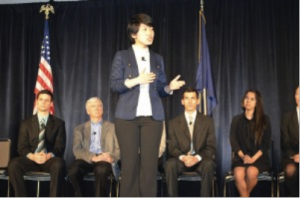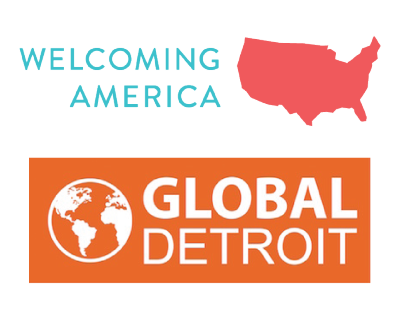Welcoming America’s Guide to Immigrant Economic Development: International Student Retention
 When you meet Xiaoyu (“Skyin”) Yin, a Chinese international student who graduated with a Master’s Degree in Advertising from Michigan State University in 2013, you are grabbed instantly by her enthusiasm, charm, wit, and intellect. “I came to the United States to see a different world,” Skyin says. “I’m glad Michigan is what I found . . . The opportunities here in Michigan are unique. I’m from China. Michigan is my second home. I am proud to call myself a ‘Michigander.’”
When you meet Xiaoyu (“Skyin”) Yin, a Chinese international student who graduated with a Master’s Degree in Advertising from Michigan State University in 2013, you are grabbed instantly by her enthusiasm, charm, wit, and intellect. “I came to the United States to see a different world,” Skyin says. “I’m glad Michigan is what I found . . . The opportunities here in Michigan are unique. I’m from China. Michigan is my second home. I am proud to call myself a ‘Michigander.’”
Skyin’s journey to her current position as the Communications and Experiential Learning Coordinator at the Office of International Students and Scholars at Michigan State University wasn’t always easy. With the help of the Michigan Global Talent Retention Initiative, one of the nation’s only international student retention programs, Skyin was able to work for Message Makers, an award-winning global event planning, video production, and instructional design company in Lansing, accessing the Optional Practical Training (OPT) benefit of her international student visa during her first year after graduation. She was even a featured speaker in Michigan Governor’s Talent Summit (see picture below).
 At Message Makers, Skyin provided valuable insight into Chinese markets and customers, as well as contributing to the company’s local work. The firm valued her contributions so much that they paid a lawyer and accompanying filing fees to secure an H-1B visa for Skyin to extend her employment, but unfortunately, like for most applicants, the application was rejected because of the high demand for H-1B visas. Fortunately for Skyin and Michigan’s economy, Skyin learned of an opening at Michigan State University (universities are exempt from the H-1B cap) and after multiple rounds of interviews, Skyin was offered the position. As a result, the University would file a new H-1B petition on her behalf and she would be allowed to continue working in the United States. She is now a contributing taxpayer to the Michigan economy, and enriches her community and the social contours of the region through the network of friends and neighbors she built during her time in Lansing.
At Message Makers, Skyin provided valuable insight into Chinese markets and customers, as well as contributing to the company’s local work. The firm valued her contributions so much that they paid a lawyer and accompanying filing fees to secure an H-1B visa for Skyin to extend her employment, but unfortunately, like for most applicants, the application was rejected because of the high demand for H-1B visas. Fortunately for Skyin and Michigan’s economy, Skyin learned of an opening at Michigan State University (universities are exempt from the H-1B cap) and after multiple rounds of interviews, Skyin was offered the position. As a result, the University would file a new H-1B petition on her behalf and she would be allowed to continue working in the United States. She is now a contributing taxpayer to the Michigan economy, and enriches her community and the social contours of the region through the network of friends and neighbors she built during her time in Lansing.
The Brookings Institution estimates that the number of F-student visas (by far the most common international student visa for higher education) grew from 110,000 to 524,000 between 2001 and 2012—a nearly five-fold increase in little more than a decade. Two-thirds of the international students pursuing a bachelor’s or higher degree are in STEM fields or business, management and marketing fields versus 48 percent of domestic students. The Journal of Corporate Recruiting Leadership estimates that international students and graduates comprise:
- 50 percent of all new U.S. Ph.D.’s in engineering;
- 45 percent of all new U.S. Ph.D.’s in life sciences, physical sciences, and computer sciences;
- 40 percent of all new U.S. master’s degrees in computer sciences, physical sciences, and engineering; and
- 25 percent of all practicing physicians.
In addition to enriching cultural and academic exchange and internationalism at universities and colleges, international students have a significant positive economic impact on the local communities where they study. NAFSA, the Association of International Educators, estimates that their tuition, fees, and living expenses meet the technical definition of an export product and collectively account for more than $24 billion of consumption on an annual basis, supporting 313,000 jobs as a result of this spending.
International Student Retention Model Programs
Only recently has the opportunity to retain these talented international students caught the eye of economic development and public policy leaders. Global Detroit oversees the Michigan Global Talent Retention Initiative (GTRI), a program that includes 32 Michigan colleges and universities, as well as over 60 Michigan employers. The program was launched in 2011 to retain this talent and to help fill unmet talent needs. Michigan Governor Rick Snyder has endorsed the program, noting, “The message to international students who take part in GTRI events is simple. Michigan wants you! Connecting highly skilled international students with employers and giving them the opportunity to work and live in a beautiful, vibrant state will help create a strategic advantage for our state and strengthen the Michigan economy.”
The Ohio Board of Regents is not far behind, recently issuing a report that contends boosting Ohio’s retention of international students to national averages would “generate almost $100 million in the state’s economy and support more than 1,000 new jobs.” The Board of Regents is working with Governor John Kasich and the local economic development infrastructure to design and implement an international student retention program.
The St. Louis Mosaic Project, a regional initiative to capitalize on the economic benefits of increasing the foreign-born population, runs a Global Talent Hiring Program focused on six strategies to help the region retain international students. The program includes engaging both the international student services and career services offices of eight local universities, along with the Regional Business Council, to share best practices and identify collaborative opportunities. In September 2015, St. Louis Mosaic worked with a local university to publish a report on international student retention that included seven specific strategy recommendations.
Where to Learn More
Welcoming America’s Guide to Immigrant Economic Development contains a chapter that chronicles the economic opportunities that international student retention can create, as well as eleven other strategies employed by local immigrant economic development initiatives across the country. It is the first guide detailing the economic development opportunities and strategies for local economic development leaders, public policymakers, chambers of commerce, immigration advocates, nonprofit organizations, philanthropic leaders, and others who want to build a more prosperous and inclusive economy. You can download your free copy of the guide here.



